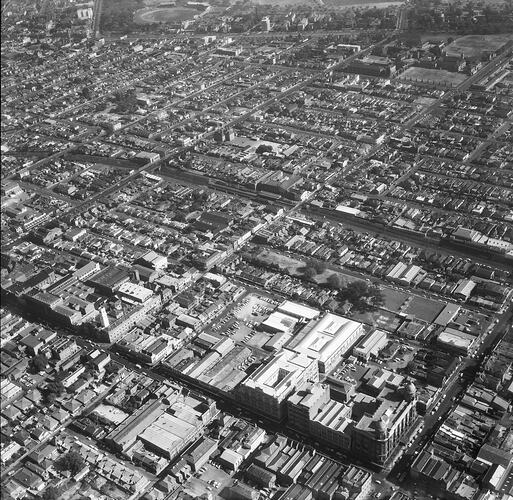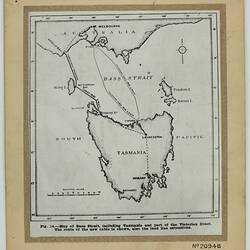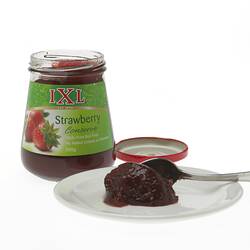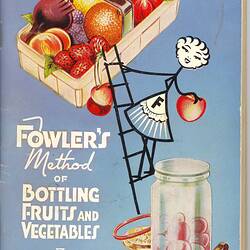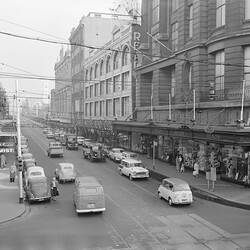An Industry in Decline
In the post World War Two era, the jam production business of H. Jones and Co was impacted upon by a market downturn and a reduction in profits. Where as at the turn of the century, the company had been able to expand, buying premises in Melbourne and Sydney, and reaching markets in England, South Africa and New Zealand, by the 1950s, international competition had begun to curtail profits. Company directors continually lamented the rising cost of production, including wages and raw materials. Publicity surrounding the company's annual meetings was used to announce the difficulties facing the industry, and often to call for government action.
In December 1948, business media were told that "during the past year there have been five increases in employee's wages, and with higher manufacturing costs of tinplate and other materials, the company's future margin of profit on jams must be narrowed or must disappear".(The Sun, 8/12/1948, page unknown). In December 1954, it was reported that future profits would be reduced, as "in all items of the main manufacturing costs- sugar, tinplate, fruit, wages, and also freight- the company was at a great disadvantage with its overseas competitors" (The Age, 21/12/1954).
During the 1950s, jam manufacturing was reported to have lessened. However, the company remained profitable, with canned fruit in particularly high demand (Australian Food Manufacture, 5/01/1954). By the end of the 1960s, the company's profits had decreased, and were being made at a rate less than that of the beginning of the decade (Fomin and Spierings, 1984, p 55). This decreasing profit margin and the archaic structure of the company, with management of brands which IXL had early taken over remaining and much overlap of brand functions led to a takeover bid in 1972, led by John Elliot of Food Canning Industries Ltd (Fominand Spierings, 1984, p 55). Jam production at the AJC factory stopped around Easter 1973 (Fomin and Spierings, 1984, p56).
During the following years, redevelopment plans were announced and refined. The A.J.C. factory would be transformed into a shopping and entertainment complex. In 1975, the environmental impact report for the project was published, envisaging the development as part of the gentrification of the area. Demographic data cited within the report showed Prahran and South Yarra would see an increased white collar work force in the area and a decreasing blue collar one betwen 1966 and 1971 (Interplan Pty Ltd, 1975, pp 82-83, p 85). So too, those who filled the remaining blue collar positions within the Prahran area were more likely to live in other suburbs including Box Hill, Springvale or Oakliegh than within the local community (Interplan Pty Ltd., 1975, p86). The developers aims included providing white collar, semi-skilled jobs, such as in retail and making available amenities perceived as being needed by the area's "new residents", who were often wealthier than former residents (Interplan Pty Ltd., 1975, pp 92-96).
The new shopping complex opened on October 9th, 1979. The site's past use for jam manufacture was drawn upon within marketing for the new complex. Within the centre, relics of this past were displayed (Fomin and Spierings, 1984, p 57). And, at the opening, Barry Humphreys' character, Dame Edna Everage, gave a speech entitled "Ode to the Jam Factory" which, though following the performer's usual satirical style, reflected the nostalgia at which the marketing campaign had aimed. "Long I would sometimes go as a special treat with my wonderful white haired gran and the chimney that towered over Chapel Street lent a strawberry smell to Prahran" (Dame Edna Everage, 1979) However, as Fomin and Spierings show, this appeal to nostalgia belies the fact that the shopping complex was being opened as a result of change in the local area and ultimately cemented a break with its past (Fomin and Spierings, 1984). The changing function of the site was both a result of, and was put forward as furthering, the demographic change seen in the area, with a decline in blue collar workers (Interplan, 1975, p 92). Thus, whilst the machinery on display and the complex's name hark back to former days, the report states that "the majority of employment opportunities provided by the new Jam Factory will be for white collar workers in occupations such as sales, administration, clerical and professional." (Interplan, 1975, p 92). Moreover, though the site would create employment for 381 from the outset, as the report was written after jam production had ceased at the factory, no mention was made as to the jobs moved or lost through this changed function (Interplan, 1975).
References
'Henry Jones States Jams Overproduced', in The Sun, 8/12/48, page unknown.
'Canned Goods: Less Profitable Markets Abroad; Future trading in the world's markets would be much more difficult and less profitable', in The Age, 21/12/1954
'Henry Jones Co-Operative ltd.', in Australian Food Manufacture, 5th January 1954, number 6, volume 23
Feodora Fomin & John Spierings, 'The Recovery and Transformation of the Jam Factory', Melbourne Historical Journal, Vol. 16, 1984
'The Politics of History', pp 48-59
Dame Edna Everage, 'Ode to the Jam Factory', 1979, Copyright Dame Edna Everage, 1979.
More Information
-
Keywords
-
Localities
-
Authors
-
Article types
